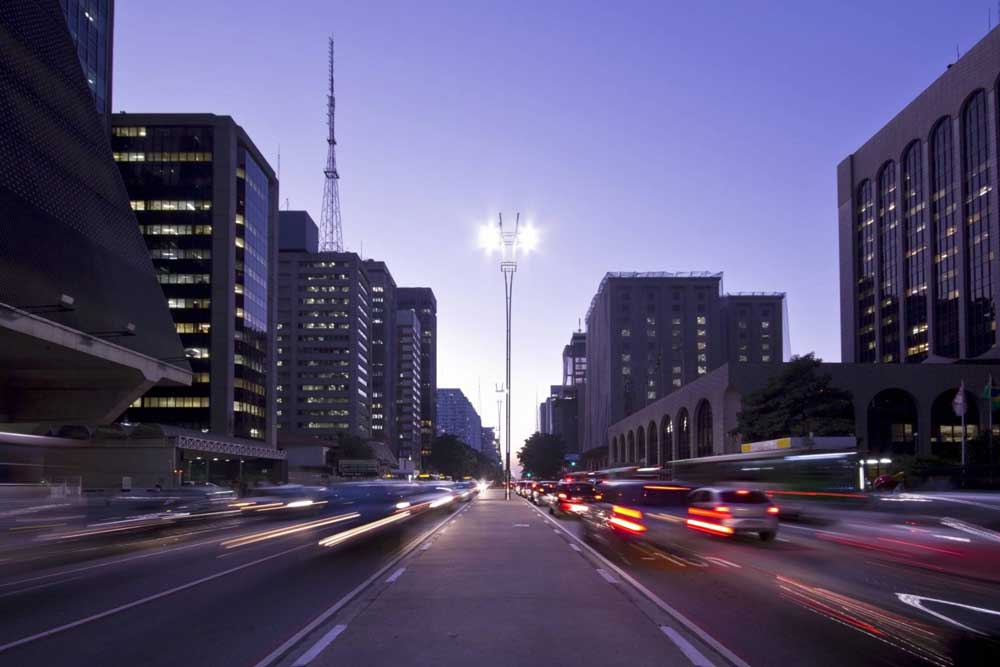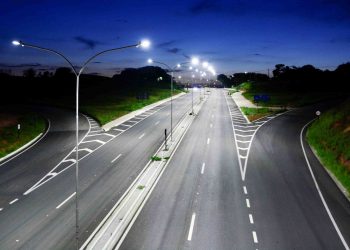
When to invest in LED street lighting
Investing in LED street lighting is an inevitable trend for the coming years due to its various benefits. It significantly reduces costs, decreases environmental impact, and increases the quality of this important service for the population.
This is due to the technological advancement offered by LED luminaires and floodlights. With a small amount of electrical current, it is possible to generate powerful beams. Furthermore, LED technology brings end-to-end sustainability, reduces the total operational cost, and allows for full integration with other technologies.
We will explain each of these points in more detail below. Stay tuned!
Why does LED street lighting offer so many advantages?
To understand the potential of LED technology, we need to explain how traditional street lighting lamps work, such as incandescent, ionized vapor, and fluorescent lamps. Unlike residential, commercial, and industrial lighting, we are talking about a public service, monitored by citizens and various organizations.
It is governed by a specific technical standard, NBR-5101, and has safety and citizen protection objectives, such as:
- Offering clarity for vehicle maneuvers;
- Bringing greater contrast and clarity so that pedestrians can visualize obstacles on sidewalks and public roads;
- Inhibiting the action of criminals, who usually take advantage of poorly lit areas to act.
Why is street lighting with traditional equipment less efficient?
We will now explain how each type of lamp works and their disadvantages.
Incandescent lamps
Currently, they are very rare in street lighting and use a metallic filament, usually tungsten, inside a vacuum or nitrogen gas bulb.
When an electrical current passes through it, there is light emission. They have a very low rated life because the filament breaks before 10,000 hours of use. In addition, they have low luminous efficiency, as they release a lot of heat, and a high power consumption is required to illuminate well.
High-pressure mercury vapor lamp
It is also a very traditional option and one of the most used models in street lighting until the 2010s. For its operation, it is necessary for the mercury to vaporize and the subsequent ionization of gases inside the lamp bulb. With the passage of electrical current in this internal atmosphere, a warm-colored light is produced, facing reddish-yellow.
This process is much more energy-efficient than incandescent lamps and has a longer rated life. However, mercury is an important environmental pollutant and must be properly disposed of.
High-pressure sodium vapor lamp
The mechanism is very similar to that explained in the mercury lamp. However, this metal is replaced by sodium, which is not considered an environmental pollutant. For this reason, it has been frequently used as a replacement.
However, it presents obstacles that bring dissatisfaction to users: the low color rendering index and excessively yellowish tone of the light beams give the impression that it does not illuminate adequately. Therefore, it may not bring the necessary clarity for maneuvers and the impression of security that adequate street lighting brings.
Metal halide lamp
Its mechanism is identical to the previous two options. However, instead of mercury or sodium, several other metal vapors are added to the interior of the light bulb. Consequently, there is the production of light beams across the visible spectrum, resulting in a cold tone of high color rendering and brightness.
Fluorescent Magnetic Induction Lamp
It uses mercury vapors, but the light is produced by magnetic force stimulation. The electric current passes through a conductor wire, generating a circular magnetic field inside the lamp’s bulb. Its advantage is its high durability, with over 60,000 hours of use. However, it has a high cost, which makes it unfeasible for widespread use.
Why is investing in LED street lighting so advantageous?
LED technology is much more advanced than traditional options. As scientific and technological studies have shown, it combines all the advantages of traditional options without their respective inconveniences!
Luminous Efficiency
Light is produced by stimulating a light-emitting diode (LED). It is made from a semiconductor material – similar to those used in computers.
With a small amount of electric current, LEDs can generate luminance equivalent to the higher powers of traditional lamps. The relevance of this technology is so significant that its inventors won the Nobel Prize in Physics in 2014.
This is because LEDs have a higher utilization of electrical energy, dissipating minimal heat. Each watt of power from an LED luminaire offers, on average, the same illumination as:
- 8-10 watts of incandescent and halogen lamps;
- 2 watts of fluorescent lamps;
- 2 watts of sodium vapor lamps;
- 2.1 watts of mercury vapor lamps;
- 1.2 watts of metal vapor lamps.
Durability and Easy Maintenance
Among all the models, LED luminaires are certainly the most durable, requiring less replacement. See the average rated life of each model below:
- Incandescent lamps – 750 to 1,000 hours;
- Fluorescent lamps – 6,000 to 24,000 hours;
- Mercury vapor lamps – 9,000 to 15,000 hours;
- Sodium vapor lamps – 18,000 to 32,000 hours;
- Metal vapor lamps – 8,000 to 12,000 hours;
- LED – 25,000 to 100,000 hours.
In street lighting, this is very significant because any bulb replacement can have a huge impact. It will be necessary to move labor with appropriate transportation and safety equipment and interrupt part of local traffic. Meanwhile, users will be quite dissatisfied with the failure of a point.
In this sense, investing in LED street lighting and choosing a more durable option, even if the model costs a little more, is an excellent option. After all, the resources required for replacement and user complaints will bring a much higher operating cost.
Sustainability
Due to its higher energy efficiency, LED street lighting is one of the best ways to achieve the company’s sustainability goals. It is possible to achieve a reduction in consumption from two to eight times, depending on the previously used model.
In addition, LED luminaires and floodlights contribute to the policy of reducing the exploitation of natural resources and solid waste production. Since a small amount of semiconductor is capable of generating high luminance, and there is no need for gas in the lamp’s bulb, the parts can be much smaller.
The materials used are entirely recyclable and non-toxic to living organisms (unlike mercury). This reduces the environmental impact of solid material extraction and production and the volume of waste produced by street lighting.
Quality
To invest in LED street lighting, the quality of the lamp can be measured by the color rendering index (CRI), which reflects how faithfully the colors of an object are transmitted with the light beams of the equipment:
- Incandescent – 100%;
- Halogen – 100%;
- Fluorescent – 80%;
- Mercury vapor – 40 to 55%;
- Sodium vapor – 22%;
- LED – 70 to 95%.
In this sense, among the viable options for street lighting, LED technology is the one that offers better clarity and contrast.
More efficient management
This is also another great differential. LED floodlights and luminaires are perfectly compatible with the most advanced street lighting management technologies:
- As they have low energy consumption and reduced volume, it is possible for the equipment to be powered by solar energy produced in embedded photovoltaic panels or integrated by photoelectric relays;
- When integrated with local sensors, dimmable LED luminaires can adjust the intensity of their own beams according to the environment;
- Furthermore, they can be fully integrable with public lighting network management technologies – with this, several functionalities can be added, such as remote control of equipment and automated equipment failure alerts.
Therefore, LED street lighting represents a great advance for the sector that provides this type of service. There is a multifactorial reduction in costs, better management of service quality, greater compliance with regulations, greater user satisfaction, among other benefits.
Want to know more about LED lighting technology or receive tips on lighting projects? Follow our pages on Facebook, Instagram, LinkedIn, and Youtube!
Share







